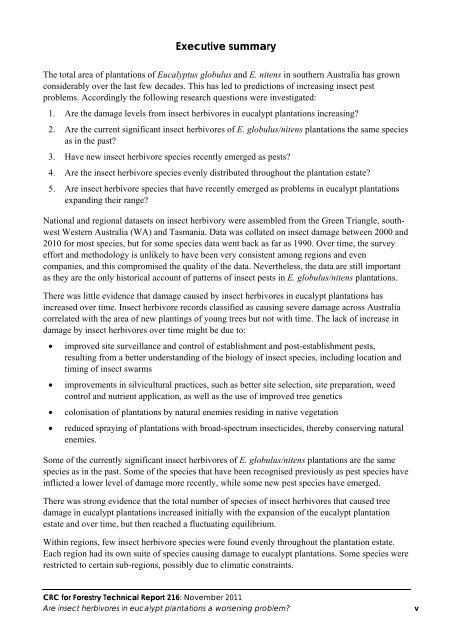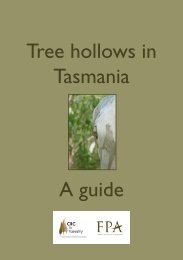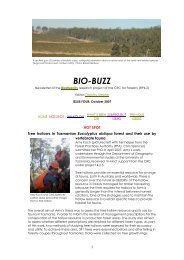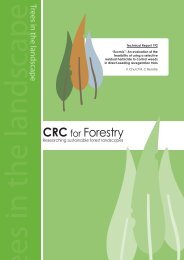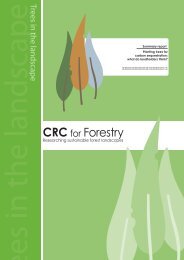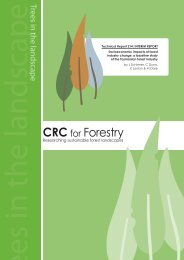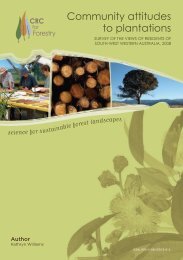CRC Forestry - CRC for Forestry
CRC Forestry - CRC for Forestry
CRC Forestry - CRC for Forestry
You also want an ePaper? Increase the reach of your titles
YUMPU automatically turns print PDFs into web optimized ePapers that Google loves.
Executive summary<br />
The total area of plantations of Eucalyptus globulus and E. nitens in southern Australia has grown<br />
considerably over the last few decades. This has led to predictions of increasing insect pest<br />
problems. Accordingly the following research questions were investigated:<br />
1. Are the damage levels from insect herbivores in eucalypt plantations increasing?<br />
2. Are the current significant insect herbivores of E. globulus/nitens plantations the same species<br />
as in the past?<br />
3. Have new insect herbivore species recently emerged as pests?<br />
4. Are the insect herbivore species evenly distributed throughout the plantation estate?<br />
5. Are insect herbivore species that have recently emerged as problems in eucalypt plantations<br />
expanding their range?<br />
National and regional datasets on insect herbivory were assembled from the Green Triangle, southwest<br />
Western Australia (WA) and Tasmania. Data was collated on insect damage between 2000 and<br />
2010 <strong>for</strong> most species, but <strong>for</strong> some species data went back as far as 1990. Over time, the survey<br />
ef<strong>for</strong>t and methodology is unlikely to have been very consistent among regions and even<br />
companies, and this compromised the quality of the data. Nevertheless, the data are still important<br />
as they are the only historical account of patterns of insect pests in E. globulus/nitens plantations.<br />
There was little evidence that damage caused by insect herbivores in eucalypt plantations has<br />
increased over time. Insect herbivore records classified as causing severe damage across Australia<br />
correlated with the area of new plantings of young trees but not with time. The lack of increase in<br />
damage by insect herbivores over time might be due to:<br />
� improved site surveillance and control of establishment and post-establishment pests,<br />
resulting from a better understanding of the biology of insect species, including location and<br />
timing of insect swarms<br />
� improvements in silvicultural practices, such as better site selection, site preparation, weed<br />
control and nutrient application, as well as the use of improved tree genetics<br />
� colonisation of plantations by natural enemies residing in native vegetation<br />
� reduced spraying of plantations with broad-spectrum insecticides, thereby conserving natural<br />
enemies.<br />
Some of the currently significant insect herbivores of E. globulus/nitens plantations are the same<br />
species as in the past. Some of the species that have been recognised previously as pest species have<br />
inflicted a lower level of damage more recently, while some new pest species have emerged.<br />
There was strong evidence that the total number of species of insect herbivores that caused tree<br />
damage in eucalypt plantations increased initially with the expansion of the eucalypt plantation<br />
estate and over time, but then reached a fluctuating equilibrium.<br />
Within regions, few insect herbivore species were found evenly throughout the plantation estate.<br />
Each region had its own suite of species causing damage to eucalypt plantations. Some species were<br />
restricted to certain sub-regions, possibly due to climatic constraints.<br />
<strong>CRC</strong> <strong>for</strong> <strong>Forestry</strong> Technical Report 216: November 2011<br />
Are insect herbivores in eucalypt plantations a worsening problem? v


